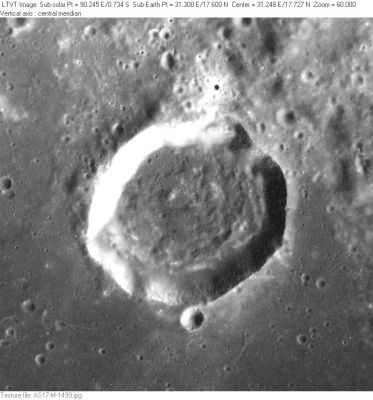Difference between revisions of "Vitruvius"
| Line 6: | Line 6: | ||
|} | |} | ||
<div id="toc"> | <div id="toc"> | ||
| − | + | [http://www.lpod.org/coppermine/albums/userpics/Vitruvius_AS17-M-1499_LTVT.JPG [[Image:normal_Vitruvius_AS17-M-1499_LTVT.JPG|external image normal_Vitruvius_AS17-M-1499_LTVT.JPG]]]<br /> ''[http://lpod.org/coppermine/displayimage.php?pos=-2480 AS17-M-1499]''<br /> <br /> | |
| − | |||
==Images== | ==Images== | ||
[http://www.lpod.org/coppermine/thumbnails.php?album=search&type=full&search=Vitruvius LPOD Photo Gallery] [http://www.lpi.usra.edu/resources/lunar_orbiter/bin/srch_nam.shtml?Vitruvius%7C0 Lunar Orbiter Images] [http://www.lpi.usra.edu/resources/apollo/search/feature/?feature=Vitruvius Apollo Images] (see also: [http://www.lpi.usra.edu/resources/apollo/search/feature/?feature=Vitruvius%2C+east+of&sort= Vitruvius, east of])<br /> '''- Vitruvius''' was also photographed during the historic first manned mission to the moon in december 1968 (Apollo 8).<br /> See [http://history.nasa.gov/ap08fj/photos/13-e/med/as08-13-2347.jpg AS08-13-2347] and [http://history.nasa.gov/ap08fj/photos/13-e/med/as08-13-2350.jpg AS08-13-2350].<br /> On both photographs, the camera was looking northward at the mountainous region around Apollo 17's Taurus-Littrow landing site (december 1972).<br /> '''Vitruvius''' itself is the pronounced crater with the shadowed interior and the small craterlet on its southern rim. The wrinkle-ridged region in the foreground is part of Mare Tranquillitatis.<br /> - A shadowless '''Vitruvius''' was captured near the right margin of the oblong panoramic ''ITEK''-camera frame [http://www.lpi.usra.edu/resources/apollo/frame/?AS15-P-9862 AS15-P-9862].<br /> - Research orbital Apollo photographs: Danny Caes<br /> <br /> | [http://www.lpod.org/coppermine/thumbnails.php?album=search&type=full&search=Vitruvius LPOD Photo Gallery] [http://www.lpi.usra.edu/resources/lunar_orbiter/bin/srch_nam.shtml?Vitruvius%7C0 Lunar Orbiter Images] [http://www.lpi.usra.edu/resources/apollo/search/feature/?feature=Vitruvius Apollo Images] (see also: [http://www.lpi.usra.edu/resources/apollo/search/feature/?feature=Vitruvius%2C+east+of&sort= Vitruvius, east of])<br /> '''- Vitruvius''' was also photographed during the historic first manned mission to the moon in december 1968 (Apollo 8).<br /> See [http://history.nasa.gov/ap08fj/photos/13-e/med/as08-13-2347.jpg AS08-13-2347] and [http://history.nasa.gov/ap08fj/photos/13-e/med/as08-13-2350.jpg AS08-13-2350].<br /> On both photographs, the camera was looking northward at the mountainous region around Apollo 17's Taurus-Littrow landing site (december 1972).<br /> '''Vitruvius''' itself is the pronounced crater with the shadowed interior and the small craterlet on its southern rim. The wrinkle-ridged region in the foreground is part of Mare Tranquillitatis.<br /> - A shadowless '''Vitruvius''' was captured near the right margin of the oblong panoramic ''ITEK''-camera frame [http://www.lpi.usra.edu/resources/apollo/frame/?AS15-P-9862 AS15-P-9862].<br /> - Research orbital Apollo photographs: Danny Caes<br /> <br /> | ||
| Line 33: | Line 32: | ||
<br /> | <br /> | ||
---- | ---- | ||
| − | + | </div> | |
Revision as of 16:57, 15 April 2018
Contents
Vitruvius
|
Lat: 17.6°N, Long: 31.3°E, Diam: 29 km, Depth: 1.88 km, Rükl: 25, Upper Imbrian |
Images
LPOD Photo Gallery Lunar Orbiter Images Apollo Images (see also: Vitruvius, east of)
- Vitruvius was also photographed during the historic first manned mission to the moon in december 1968 (Apollo 8).
See AS08-13-2347 and AS08-13-2350.
On both photographs, the camera was looking northward at the mountainous region around Apollo 17's Taurus-Littrow landing site (december 1972).
Vitruvius itself is the pronounced crater with the shadowed interior and the small craterlet on its southern rim. The wrinkle-ridged region in the foreground is part of Mare Tranquillitatis.
- A shadowless Vitruvius was captured near the right margin of the oblong panoramic ITEK-camera frame AS15-P-9862.
- Research orbital Apollo photographs: Danny Caes
Maps
(LAC zone 43D4) LAC map Geologic map LTO map
Description
Description: Elger
(IAU Directions) VITRUVIUS.--A ring-plain 19 miles in diameter with bright but not very lofty walls, situated among the mountains near the S.E. side of the Mare Serenitatis. It is surrounded by a region remarkable for its great variability in brightness. There is a large bright ring-plain on the E., with a less conspicuous companion on the S. of it.
Description: Wikipedia
Additional Information
- Depth data from Kurt Fisher database
Pike, 1976: 1.88 km
Arthur, 1974: 1.55 km
Westfall, 2000: 1.88 km
Viscardy, 1985: 1.55 km
Cherrington, 1969: 2.31 km - Vitruvius A is a thermal anomaly crater, implying youthful age - Moore et al, 1980
Nomenclature
- Vitruvius Pollio, Marcus; Roman engineer, architect (unkn-fl. c. 25 B.C.).
- Crater Vitruvius B was called Fisher by Wilkins and Moore, but the I.A.U. did not accept that name. Fisher was an American astronomer (1878-1949).
- Crater Vitruvius G was unofficially called El Greco on Lunar Topographic Ortophotomap 61-A1. Who was El Greco? See this Wikipedia-page.
LPOD Articles
Bibliography
